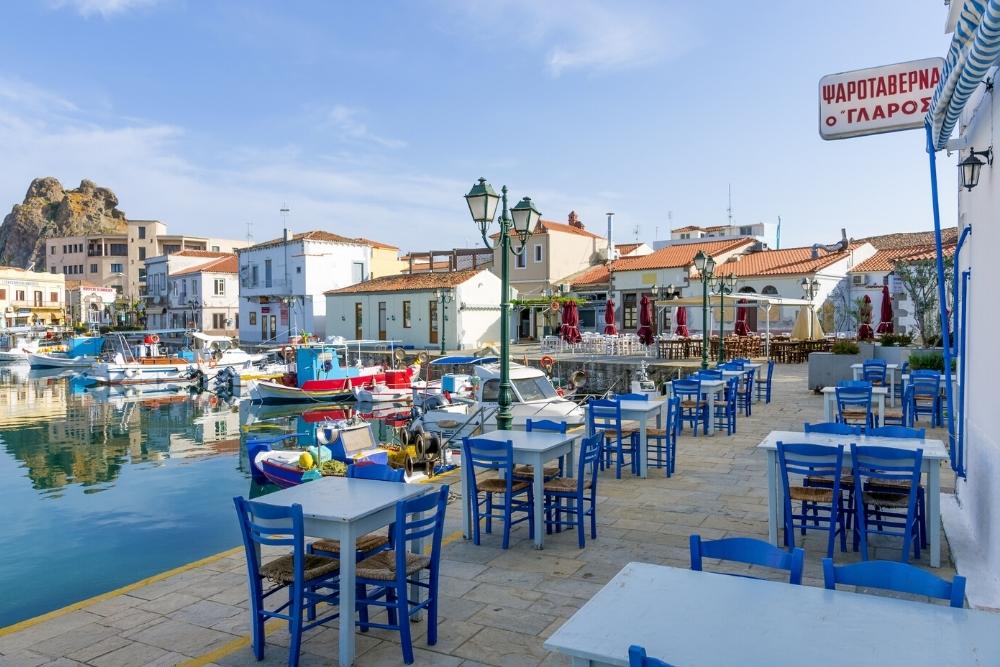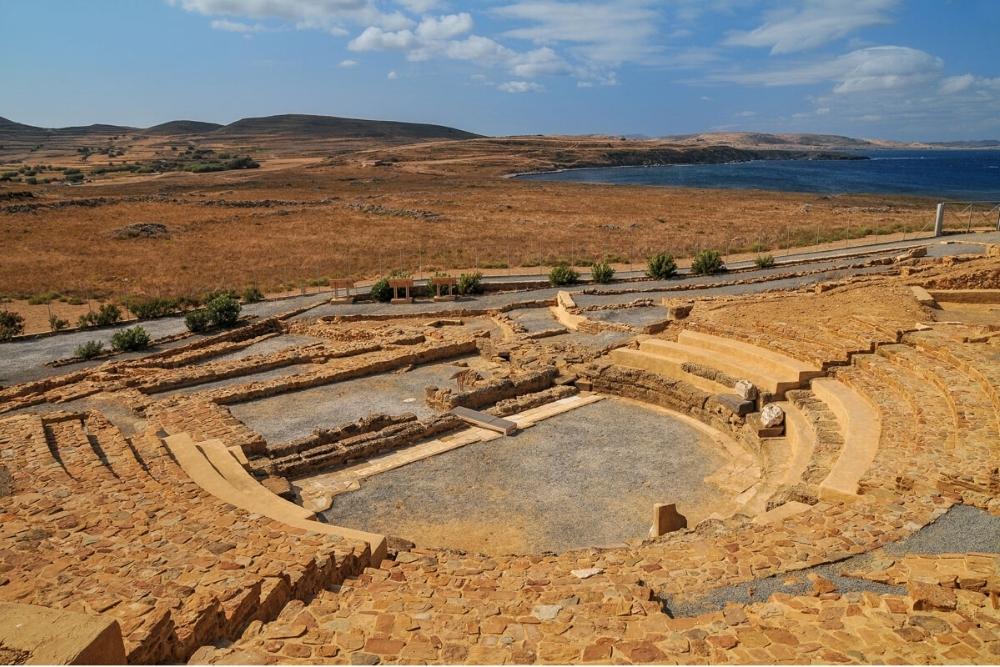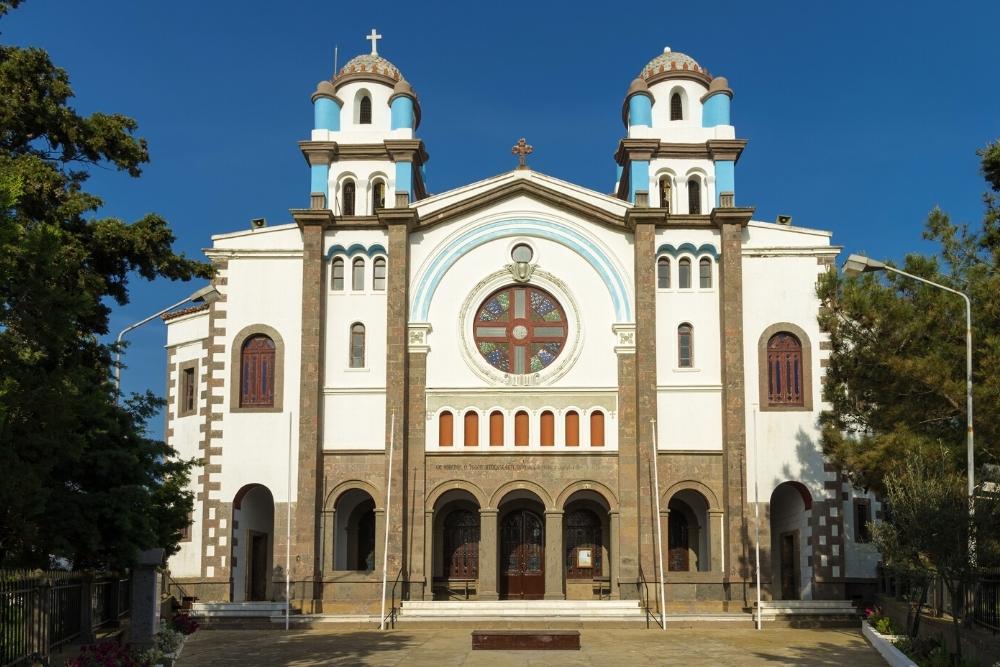Lemnos (or Limnos, as it is also called) is an island in the northern Aegean Sea, between the Halkidiki peninsula and the coast of Turkey (or between Thassos and Lesbos, depending on how you want to look at it), which could be defined as somewhat atypical compared to other Greek islands. The unique landscape of Lemnos, with its green hills and vineyards, bays upon bays, and dozens of beautiful beaches, sand dunes, and other bizarre geological formations, invites visitors to explore its alluring nature, traditional villages, and archaeological sites that bear witness to a civilization with a centuries-old history.
Looking into mythology, Lemnos is the home of the Amazons and Hephaestus, the god of fire and volcanoes. It was here that Hephaestus had his blacksmith’s workshop, and one of the towns on Lemnos, Ifestia, was named in his honor. Legend has it that Hephaestus came to Lemnos after being thrown off Mount Olympus by his parents, Hera and Zeus, who couldn’t bear to have such an ugly child. Hephaestus fell on the island, broke his leg, and was left lame, but the locals nursed him back to health and taught him the art of blacksmithing.

Another legend associates the island of Lemnos with Philoctetes, son of Peante, king of Meliboea, an ancient hero who was abandoned here during the Athenian expedition against Troy. He was bitten on the leg by a snake (another version says he had a nasty wound from a blood-soaked arrow shot by Heracles) so the leaders of the Athenians had to leave him on the desolate island of Lemnos, where Philoctetes survived for ten years, thanks to Heracles’ bird-killing arrows.
Last but not least, Lemnos is said to have been one of the places inhabited by the famous female warriors called Amazons. Another legend says that when Jason and his Argonauts stopped over in Lemnos on their way to search for golden wool, they were warmly welcomed by the Amazons and their queen, Hypsipyle, with whom Jason had twin sons.

Therefore, the island of Lemnos is a place of legends, which you will never see overrun by tourist hordes. The good, cheap food, quality wines, honey, cheese, and pasta of Lemnos add to the picture of a blessed land with plenty of reasons to visit.
- What to do and see in Lemnos
- Map with main tourist attractions in Lemnos island (zoom for details)
- Castle of Myrina
- Sand dunes near Gomati
- Hephaistia and the mysteries of Cabiris
- The ancient settlement of Poliochni
- Church of Panagia Kakaviotissa
- Geological formations at Cape Falakro
- Moudros village
- Lemnos beaches
- Best hotels in Lemnos
- Best restaurants in Lemnos
- How to get to Lemnos
- Pin it!
What to do and see in Lemnos
Besides the capital Myrina, the island of Lemnos has a few other ‘secret’ places that are a shame not to explore when you visit.
Map with main tourist attractions in Lemnos island (zoom for details)
Castle of Myrina

Myrina is the capital of Lemnos and its main town. And the castle at the highest point of the city is the most visited tourist attraction on the island. It was built by the Byzantine emperor Andronikos I Komninos (1118-1885) on the site of ancient walls. The Venetians continued to build it after they occupied Lemnos.

The walk up to the castle may seem tiring, but you’ll certainly forget about the effort quickly once you take in the breathtaking scenery once you reach the top. In addition to the castle, visitors can admire the ruins of a Turkish mosque, several other houses and some of the Dama deer that populate the place, descendants of those donated by the municipality of Rhodos in 1968.

Otherwise, visitors to Myrina will be pleasantly impressed by the neoclassical-style houses or the Ottoman buildings, the narrow streets leading to the small harbor. Many restaurants and cafés in the port and various shops sell souvenirs and handicrafts, ceramics, pasta, wine, and beekeeping products.
Sand dunes near Gomati

The desertified Ammothines region offers a landscape unlike anywhere else in Greece: sand dunes and rich vegetation. Ammothines is located in the northern part of the island, and the 70,000 square meter area is reached by a country road from the village of Katalakkos. It’s a good place for landscape photography, as well as a hike to nearby Gomati beach.
Hephaistia and the mysteries of Cabiris

The ruins of Hephaistia are remnants of an ancient city that flourished during the 5th and 4th centuries BC. The god Hephaestus was the protector of this city, and as a result, he was highly revered here. To the north of Cape Chloe, you will discover the sanctuary of the Cabirs, also dedicated to Hephaestus. According to legend, the Cabirs were his twin children, and the sanctuary was the scene of the Cabir mysteries, which had to do with the rebirth of nature and fertility.
The ancient settlement of Poliochni

Some specialists consider Poliochni to be the oldest settlement in Europe. Archaeologists have uncovered a series of four chronologically different settlements built on top of each other. The oldest, Blue Poliochni, dates back some 6000 years. It was followed by the Green, Red, and Yellow Poliochni, the last of which was destroyed around 2100 BC during Homer’s Trojan period. They were named after the colors of the houses.
Poliochni is thought to have been a wealthy settlement, with archaeological excavations revealing many clues. It was surrounded by 5 meter high walls, which had openings for archers. As Lemnos is the site of the legendary Amazons, it is assumed that these ‘windows’ were where the female warriors stood waiting for their attackers. An engraving depicting a woman archer wearing an animal skin helmet can be seen at the ruins of Poliochni.
Church of Panagia Kakaviotissa

The small chapel of Panagia Kakaviotissa, near the village of Thanos, is worth a visit because it is housed inside a cave on the summit of Mount Kakavos (improperly called ‘mountain’, though). It was built in 1416 and served as a shelter for monks and pilgrims fleeing Ottoman raids. The chapel can be reached by car from Myrina, then a short walk along a country road, the recommendation being to come at evening time to admire the dramatic scenery at sunset.
Geological formations at Cape Falakro

At Cape Falakro, visitors discover a stunning phenomenon that features geological formations that appeared millions of years ago. Hot lava from a volcano flowed overland and ‘froze’ as soon as it contacted the seawater. The resulting image of these reddish rocks is a delight for any amateur or professional photographer.
Moudros village

Moudros is a port on the eastern side of Lemnos, known for its excellent seafood dishes, brought in every morning by fishermen scouring the Aegean depths. At the same time, Moudros is a splendid settlement that you can visit at your leisure, enjoying every step you take among the white houses, visiting the ruins of the castle on the hill, and admiring the churches of Taxiarches and Evagelistria.
Lemnos beaches
Lemnos is an island also known for its many beaches. Virtually everywhere you go towards the sea, you’ll find a beach, sandy or pebbly. Each one is different and with varying degrees of landscaping. The best beaches in Lemnos are Plati, Riha Nera, Agios Ioannis.
Plati Beach

Bars, tavernas, cafes, water sports facilities, sun loungers, and umbrellas make Plati one of the most extensive and best-organized beaches on the island of Lemnos. It’s 700m long, which means that there’s room for everyone during the peak summer months. The beach is also a great place to stroll around in the evening when you’re looking for a place to have dinner. It is located in the village of the same name, 2km from the capital Myrina.
Riha Nera Beach

Situated near Romaikos Yialos, the beautiful bay in the capital of Myrina, Riha Nera (in translation – ‘still waters’) is one of the most popular beaches in Lemnos and a very cosmopolitan one, suitable for all age groups, especially children. It is also one of the best places in Lemnos to watch the sunset.
Agios Ioannis Beach

Agios Ioannis is a small beach 6 km north of Myrina, near the village of Kaspakas. It has sand, a charming heart shape, and the bay in which it lies is framed by huge volcanic rocks. The beach is well laid out, and in addition to umbrellas and sun loungers, there are several bars and a taverna with a seafood menu.
Other beaches on the island of Lemnos

Other beautiful beaches to visit in your Lemnos holiday are: Nevgatis beach, Thanos beach, Zematas beach, Keros beach, Gomati beach, Fanari beach, Kokkina beach, Avlonas beach, Myrina beach.
Best hotels in Lemnos
Varos Village Boutique Hotel ****
Booking rating: 8.8

Varos Village Boutique Hotel is a 12-minute walk from the beach, in a central area of the restored village of Varos. The complex features a swimming pool, bar, restaurant, and fitness room. Rooms and suites are elegantly and modernly decorated, and the Veranda restaurant serves traditional Greek dishes with fresh, local ingredients.
Ethaleia Hotel ***
Booking Score: 9.8

Ethaleia is a charming hotel set on a small hill, from where you get great views of the bay of Moudros. A quiet location, very close to two good beaches: Fanaraki the small and Fanaraki the large and the sites of Poliochni and Hephaestia. Comfortable and clean rooms, furnished in antique style, friendly staff,
Afrodite Hotel Apartments **
Booking rating: 9,2

Located just 50 meters from Riha Nera Beach and a 5-minute walk from Romeikos Gialos, Afrodite Apartments has a kitchenette. Generally, they have all the amenities you’d want for a self-catering stay. The center and harbor of Myrina are 250 meters away.
Best restaurants in Lemnos

Opos Palia
A family-run Greek restaurant with good food and reasonable prices, attentive staff, and a quiet ambiance in a setting reminiscent of old Greek movies: lots of trees, flowers, lights. Opos Palia is in the village of Thanos.
Grammofono
Located in the capital Myrina, not far from the seafront, Grammofono has a less commercial and more authentic atmosphere. A rich menu with dishes that are less common for Greek islands, such as tabbouleh or portobello saute, all of which taste great.
Taverna Man-Tella
In the heart of the quiet village of Sardes, a taverna ‘grown’ since the early 90s with the idea of showing the world the rich gastronomic heritage of Lemnos. Old recipes are brought to life in a warm and welcoming atmosphere.
How to get to Lemnos
The island of Lemnos has an airport where several daily flights land from Athens, Thessaloniki, Lesbos, and Ikaria. If you don’t come by plane, you can choose a ferry, either from Piraeus and Lavrion or from islands such as Lesbos, Fourni, Ikaria, Chios, Samos, Patmos, etc. From northern Greece, ferries to Lemnos leave from Thessaloniki and Kavala. However, you should check their frequency, as this is not daily.
Pin it!


You may also like: Serifos Island, the enchanting home of the Cyclops




